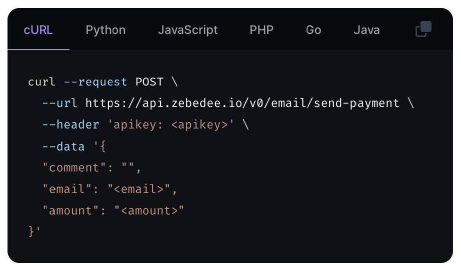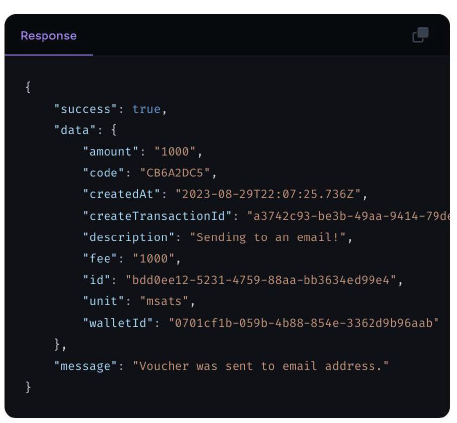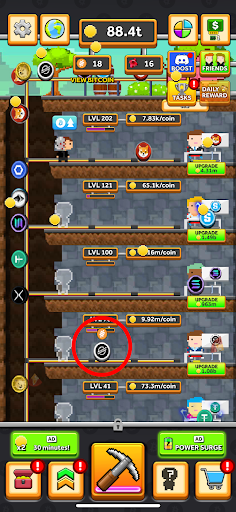| Section | What you’ll learn | Key points |
|---|---|---|
| Setting up your account | Signing up and funding your account. | - Main wallet holds most of your funds -Project wallets are connected to games and have API keys attached to them |
| Under the hood: ZBD API in your game | The backend part of using ZBD. | - Store API keys on a secure server! - The two recommended ZBD integration paths: Send to Email vs Log in with ZBD |
| The front-end: In-game UI/UX | The front end part: How players withdraw rewards and how they earn them in the first place. | - Creating a withdrawal flow (with a premade template) |
| - Earning mechanics: Simple on-size-fits-all vs custom integrations to fit a specific game |
Setting up your account
If you’ve already set up a ZBD API account, created a Project and put some Bitcoin into it, feel free to skip this section.Step 1: Sign up and verify
Signing up as a developer on ZBD is super easy. Head over to the sign-up page by clicking here. You will then have to do the following:- Verify your email
- Verify your identity/business
- If you’ve received an invite code from our BD team and signed up with that, then we will be in touch with some forms to verify your business
- If you didn’t sign up with a code, that’s totally fine. Just complete the simple ID verification process in our platform
Step 2: Create and fund Project
There are two types of wallets inside the ZBD Dashboard:- Main wallet - this is very secure and should hold most of your Bitcoin
- Projects - these are connected to API keys and should be topped up in small amounts regularly, to protect your funds from bots, hackers or simple mistakes.
- RULE OF THUMB: Create one project per game. So basically ZBD Project = rewards wallet for your game. We recommend you give your project the same name as your game.
- STATING THE OBVIOUS: If someone gets a hold of the API keys for your project wallet, they can drain all the Bitcoin inside that project.

Wallet Actions
Under the hood
ZBD API in your game
Before you get started: Do you have a server? We realize many games don’t require running any server-side code. For hypercasual and casual mobile games especially, it’s usually totally fine to run all code on the client. Unfortunately, this won’t work when you’re integrating any sort of real-money functionality. You absolutely must store the following on a secure server, or you will get robbed.- Your ZBD Project API keys - this gives access to sending out rewards
- User balances - how much a user has earned and not withdrawn yet
Beamable + ZBD Guide
Step by step integration guide for games using Beamable and ZBD.
Starter Source Code
View the source code for an example implementation of Beamable and ZBD.
Storing your API key
It is important to make sure that your ZBD API key is stored securely in your backend of choice. The API key should NOT be stored in the client.More details...
More details...
If your backend is something like Playfab you can use the built in “Internal Title Data” to save sensitive game variables such as API keys, as data stored here cannot be accessed by the client but you can retrieve it via playfab cloud script to make requests to the ZBD API directly from your Playfab backend.If you’re using PlayFab, you can find a guide here.If you are using your own backend such as node.JS or .NET you can put the API key in your .env file.As mentioned above, if you don’t have a backend solution yet, we recommend Beamable (and have a guide here)
Storing user balances
Rewards work best when the player sees them accumulating inside the game clearly. More on the UX/UI on this below (including templates), but for now, let’s talk about the server-side part of user balances. You should always store how much a user has earned (and not yet withdrawn) on the server. If you store it on the client, bad actors can decompile your game, change that variable and pay themselves. If you’re familiar with storing values on a backend, feel free to skip this next section. There’s three parts to it:- Storing user balances on the server
- You need a user identifier, such as Device ID or GAID
- You need to store a value for rewards
- Resetting the user balance when they withdraw rewards from the game to ZBD
- Displaying all that inside your game
More details...
More details...
If you are developing on services such as Unity for your game and PlayFab for your backend, then PlayFab will automatically assign each user a playfabID. You can then use PlayFab’s Economy system to store, retrieve and update the user’s balance via PlayFab’s Cloud Script. Here’s a guide for this specific setup.If you are using a custom backend such as NodeJS or .NET, you will need to set up a secure authenticated server and API using something like Express, and provision a database such as MongoDB and manually create a user entry when your app loads for the first time. It is typical to use Unity’s SystemInfo.deviceUniqueIdentifier as the unique identifier for the user.At the risk of repeating ourselves… you can also do this using Beamable. Especially if you don’t have a backend yet.
On to the ZBD API
There are a few different ways to integrate the ZBD API. These are the two we recommend for games:- Send to Email - easy to set up, very little friction for gamers.
- Ideal for integrating fast, with minimal dev work
- Gamers only need to enter their email to withdraw.
- If they already have a ZBD account -> they get Bitcoin instantly
- If they don’t have a ZBD account -> we send them an email with a voucher for the rewards and further instructions
- Log in with ZBD - a bit more setup, but more powerful features and controls
- Just like “Sign in with Google”, but for moving money.
- Ideal for games that want to build deeper integrations and have more insight into users/who is receiving rewards
The simple way: Send to Email
This is the easiest way to get started with player rewards using the ZBD API.The user’s perspective: As simple as writing their email!
Using the Send to Email API
To send Bitcoin to a given email, all you need to do is call the Send to Email API with a POST call providing the following properties: Header Your ZBD Project API key Body- The Email of the intended recipient (e.g. [email protected])
- The amount for the Payment -> in millisatoshis
- Note / description of this Payment (will be shown to recipient)
Request

Response

The advanced way: Log in with ZBD
Similar to Log in with Google/Apple/Facebook. But for moving money. Gives you access to more detail about your users, which enables advanced controls, like separate settings for ID verified users, querying a user’s balance and more.The user’s perspective: They push a Log in with ZBD button, then they confirm permissions in the ZBD app.
Integrating Log in with ZBD
First, you need to integrate Log in with ZBD - this is built on the OAuth2 protocol, so it should be pretty standard. If you are using Unity and Beamable (described above), we have a step-by-step guide and example projects for you here. If you are using other engines or backends, we have a guide for you here.Sending rewards with Log in with ZBD
Log in with ZBD is a way to get user data. You can use it to fetch a user’s ZBD Gamertag (basically their username on our system). To make payments, you just use our standard Send to Gamertag API. It’s similar to sending to email. To learn how to Send to Gamertag, check our docs here.The front-end
In-game UI/UX This part of the guide will look at two things:- ZBD Withdrawal flow - how do users cash out from your game to their ZBD App?
- Reward Mechanics - how do users actually get rewards in your game?
ZBD Withdrawal flow
Why are we starting with how users claim rewards and not with how they get them? Because this part is simple and we have established very clear best-practices and prototypes. So this should be a breeze! The Components This is what you’ll need to show inside your game:- Reward counter - how much the user has earned (and not withdrawn yet)
- Withdrawal UI - a few simple screens that allow the user to withdraw

Cashing out to a gamertag
You can find a Unity package with all required elements set up in a way that’s easy to customize here. ZBD integrations come in all shapes and sizes - it’s really up to you what you want to build and how complex you want to go. But no matter what you’re building, the withdrawal UX will work the same way. And, hopefully, that part is super clear now!
Reward mechanics
Ok, now the fun part: deciding how users earn rewards in your game. Most ZBD games go custom and build custom mechanics inside the game. But there’s also a one size fits all solution.One size fits all: time-based rewards
| Great for: | Incentivizing players to spend a certain amount of time in-game per session and keep coming back every day. |
| Pros: | Quick implementation that can be copied to any game. |
| Cons: | Only encourages time spent playing, not specific actions. Layers rewards on top, not as part of the game, making it feel a little less native. |
Messaging
It’s very important to clearly let the user know when they’ve earned a reward. We suggest showing a banner overlay every time a user earns a reward, that says: “You’ve just earned a bit of Bitcoin! Keep playing to earn more!”
Messaging example
How to not get scammed
Any system that gives out real money for playing a game will always attract exploiters. Luckily, there are powerful tools available that ensure only legitimate players can get rewards. Security essential: Play Integrity We HIGHLY recommend you add Google Play Integrity and iOS Device Check to any game that gives out real-money rewards. This will ensure only users on legitimate devices (not emulators, not rooted) can get rewards. Firebase offers a convenient Wrapper called App Check for both services that you can integrate inside of Unity. Here’s how you do it. Validating gameplay: Quago You should validate real gameplay before giving out any rewards. Because you don’t want to give rewards to users that just open a game and leave it running. You want them actually playing legitimately! To do that, you need to run some sort of anti-cheat software. Otherwise, you will get scammed! We recommend Quago for this. You can then make calls from your server or backend (PlayFab Cloud Script, Beamable micro service) to get the user’s “game play data” which will tell you if the user has cheated - used a bot, fake device, etc.Show how to integrate time-based rewards using Quago SDK
Show how to integrate time-based rewards using Quago SDK
Here’s how you can implement time-based rewards using Quago SDK (See below)You can then use total_playtime_hours to calculate how many sats you want to assign to the users balance. If inauth_playtime_percentage or emu_playtime_percentage is not 0 you can not reward any sats as the user has cheated.
Unity code
Advanced integration: custom mechanics
| Great for: | Making rewards a native and super fun part of your game. |
| Pros: | Brings maximum engagement and feels native to the game. |
| Cons: | Implementation will be different for every game and essentially becomes part of game design. But there’s always simple ways to add it to an existing game! |

Bitcoin Miner
That’s it! Thanks for reading this guide, now go and create some super rewarding experiences for your players!

